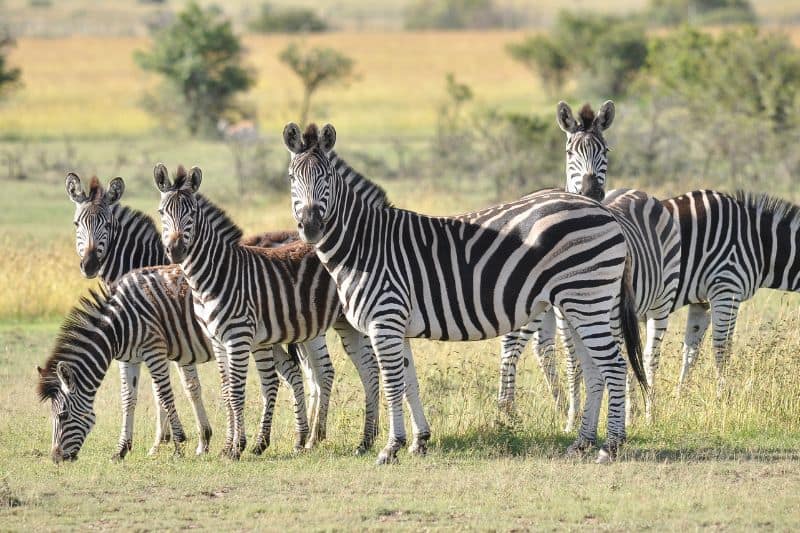As I began researching for an article on zebras, I wondered about their weight. People often discuss the distinctive and fascinating patterns of their coats, but it occurred to me that perhaps knowing their size and weight could provide additional interesting insights into these remarkable creatures.
Zebras belong to the horse family and are native to Africa, mainly residing in grasslands and savannas. There are three primary species: the plains zebra, Grevy’s zebra, and the mountain zebra. Each species differs slightly in size, build, and natural habitat, which can impact their respective weight measurements.
Gathering information about the weight of each distinct zebra species is important for understanding their ecology, behavior, and even conservation. As we explore how much a zebra weighs, we’ll better appreciate these extraordinary animals and their unique characteristics in the animal kingdom.
Read: How Much Does a Traffic Light Weigh? (Detailed Guide)
Plains Zebra typically weigh between 220 to 322 kg (485 to 710 lbs.). Mountain Zebra typically weigh between 240 to 372 kg (530 to 820 lbs.). Grevy’s Zebra, the largest zebra species, can weigh up to 450 kg (990 lbs.), while females typically weigh around 350 to 400 kg (770 to 880 lbs.).
Zebra Overview
As a zebra enthusiast, I’m excited to share some information about these amazing creatures. Zebras are distinctive for their black and white stripes, which serve as a defense mechanism against predators.
Their stripes make them difficult to isolate, confusing their predators. There are three main types of zebras, each with unique features and habitats.
Types of Zebras
- Plains Zebra: Also known as the common zebra, the Plains Zebra is the most widespread species. They have broad black stripes on a white background, with the stripe pattern differing between individuals.
- Mountain Zebra: These zebras are native to southwestern Africa and are distinguished by their square-like stripes. They also have a dewlap, which is a fold of skin along their neck.
- Grevy’s Zebra: Often considered the largest, Grevy’s Zebra’s stripes are narrower, giving them a more elegant appearance. They have a white belly and a large, rounded ear.
Habitat and Distribution
- Plains Zebra: They mostly inhabit Eastern and Southern Africa, primarily in grasslands, savannas, and woodlands. Some examples include Tanzania’s Serengeti, Kenya’s Masai Mara, and South Africa’s Kruger National Park.
- Mountain Zebra: They prefer rocky hills, mountainous regions, and semi-arid grasslands of Namibia, South Africa, and Angola.
- Grevy’s Zebra: They reside in the dry, sparse shrublands of Northern Kenya and Ethiopia.
Now that you have a brief overview of the different zebra species and their habitats, it’s important to know that the weight of a zebra can vary quite a bit depending on the species, sex, and individual.
Zebra Weight
Zebra Weight Ranges
As a zebra enthusiast, I can tell you that the weight of a zebra varies depending on the species. There are three main species of zebras, and their weight ranges are as follows:
- Plains Zebra (Equus quagga): 440 – 990 lbs (200 – 450 kg)
- Mountain Zebra (Equus zebra): 550 – 840 lbs (250 – 380 kg)
- Grevy’s Zebra (Equus grevyi): 770 – 990 lbs (350 – 450 kg)
Factors Influencing Zebra Weight
I found that several factors can influence a zebra’s weight:
- Sex: Male zebras (stallions) typically weigh slightly more than female zebras (mares).
- Habitat: Zebras living in resource-rich environments tend to be heavier than those living in environments with scarce resources.
- Genetics: Individual variations in genetics can affect the weight of zebras.
Zebra Weight at Different Life Stages
Throughout their lives, zebras experience significant changes in their bodyweight:
- Foals: When born, zebra foals weigh 55 – 88 lbs (25 – 40 kg).
- 1-3 Years: As they grow, their weight gradually increases to 50-75% of the adult weight.
- Adults: Once zebras reach maturity, their weight stabilizes within the species-specific range mentioned above.

How Zebras Maintain Their Weight?
Zebras are amazing creatures, and I’ve always been fascinated by how they maintain a healthy weight. They mainly achieve this through:
- Grazing: Zebras graze on grass and vegetation for most of the day, providing essential nutrients.
- Social Interaction: Zebras live in groups called harems, with a dominant stallion, several mares, and their offspring. This social structure helps ensure the entire group has access to resources and protection.
Remember, each zebra is unique, and their weight may be influenced by various factors like their sex, habitat, genetics, and life stage. I hope this brief overview on zebra weight gives you a helpful starting point for further exploration!
Methods to Weigh a Zebra
I recently researched various methods to weigh a zebra and found a few interesting approaches to collect accurate data. The process of weighing a zebra can be challenging because they are wild animals and generally do not cooperate.
The first method I discovered is the mobile scale method. In this approach, a specialized mobile scale is mounted on a vehicle (usually a truck) and the scale platform is placed flat on the ground.
The zebra would be led or lured onto the platform, and its weight would be recorded. This method works well for zebras that are already accustomed to human interaction, such as those in a zoo or wildlife park.
The second method I found is the crane scale method. This involves capturing the zebra and using a sling with a built-in scale to lift it off the ground. The zebra’s weight will be determined by measuring the force needed to lift it. This method is commonly used in research settings, where the zebra can be sedated for its safety and the researchers’ safety.
Another method I came across is the measurement estimation method. In this method, the zebra’s weight is estimated by taking various body measurements and comparing them to a standard database of zebra weights.
The measurements usually include body length, girth, and height. Although this method is less accurate than the other two, it may be more practical, especially when dealing with wild zebras in their natural habitats.
Read: How Much Does a Credit Card Weigh?
Weight Compared to Other Animals
When I was researching zebra weights, I found that they vary quite a bit depending on the species. There are three main species of zebras: the Plains zebra, Grevy’s zebra, and Mountain zebra. Let me give you a brief comparison of their weights to other animals:
- Plains zebra: Plains zebras typically weigh between 440 and 990 pounds (200 to 450 kilograms) – that’s quite a range! To help visualize this, a female American bison weighs around 1,000 pounds (450 kilograms) so a larger Plains zebra could be close to that weight. On the lighter end, a smaller Plains zebra could weigh about as much as a small adult male lion, which could also weigh around 440 pounds (200 kilograms).
- Grevy’s zebra: Grevy’s zebras are the largest zebra species, weighing between 770 and 990 pounds (350 to 450 kilograms). This means they can be heavier than some Plains zebras. Considering donkeys as well, Grevy’s zebras can outweigh some adult donkeys, which usually weigh between 400 and 1,100 pounds (180 to 500 kilograms).
- Mountain zebra: Mountain zebras weigh between 530 and 820 pounds (240 to 372 kilograms), making them lighter overall compared to the other two zebra species. If we consider horses, Mountain zebras are lighter than most horse breeds, such as the Arabian horse, which typically weighs between 800 and 1,000 pounds (360 to 450 kilograms).
It’s amazing to see the differences between zebra species and how they compare to other animals! I hope this comparison clarified some misconceptions and provided an interesting insight into the weight of these fascinating striped creatures.
Frequently Asked Questions
How much do African zebras typically weigh?
African zebras, specifically the Plains zebras, usually weigh between 200 and 450 kg (440 to 990 lbs). It’s important to note that their weight can vary based on age, sex, and overall health.
What is the average height and weight of a zebra?
On average, a zebra stands about 1.3 meters (4.3 ft) tall at the shoulder and weighs around 300 kg (660 lbs). Of course, these measurements can differ between individual zebras and among different species.
What is the weight range for adult zebras?
The weight range for adult zebras varies depending on the species. Plains zebras usually range from 200 to 450 kg (440 to 990 lbs), while Grevy’s zebras can weigh between 350 to 450 kg (770 to 990 lbs). Mountain zebras tend to be lighter, ranging from 220 to 390 kg (485 to 860 lbs).
Do different zebra species have varying weights?
Yes, different zebra species do have varying weights. Three primary zebra species exist: Plains, Mountain, and Grevy’s zebras. Each species has its own specific weight range, with Grevy’s zebras typically being the heaviest and Mountain zebras the lightest.
How does a zebra’s weight change throughout its life?
A zebra’s weight changes as it progresses through different life stages. When they’re born, foals usually weigh around 30 kg (66 lbs). As they grow and mature, their weight increases accordingly. Adult zebras maintain a relatively stable weight, although it can fluctuate depending on factors such as food availability, health, and age.
What factors influence a zebra’s weight?
Several factors can influence a zebra’s weight. These include:
Age: Younger zebras generally weigh less than older, fully grown individuals.
Sex: Males tend to be slightly heavier than females.
Diet: A zebra’s weight can vary depending on the availability and quality of their food sources.
Health: Illnesses and injuries can lead to changes in weight.
Species: As discussed earlier, different zebra species can have differing weight ranges.







